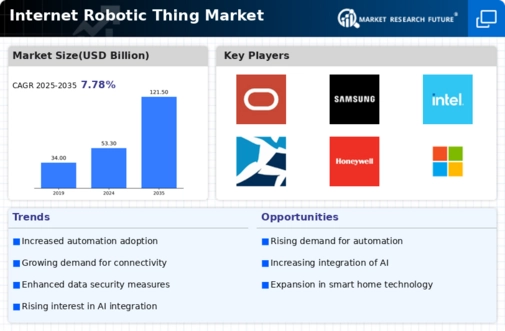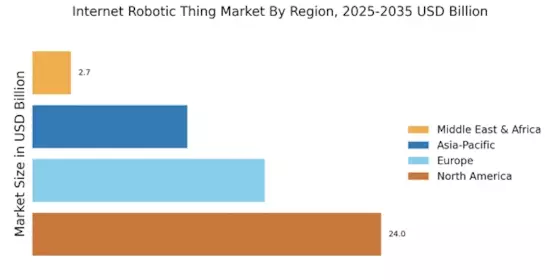Expansion of Robotics in Healthcare
The Internet Robotic Thing Market is experiencing a notable expansion in the healthcare sector. The integration of robotic technologies in medical applications is revolutionizing patient care and surgical procedures. Recent statistics indicate that the healthcare robotics market is projected to grow at a compound annual growth rate of 20% over the next five years. This growth is attributed to the increasing demand for minimally invasive surgeries and robotic-assisted rehabilitation. Furthermore, the use of robots in hospitals for tasks such as medication delivery and patient monitoring is becoming more common. As healthcare providers seek to enhance efficiency and improve patient outcomes, the Internet Robotic Thing Market is likely to see continued investment and innovation in this area.
Rising Demand for Smart Home Devices
The Internet Robotic Thing Market is experiencing a notable surge in demand for smart home devices. As consumers increasingly seek convenience and efficiency, the integration of robotic technologies into everyday household items is becoming commonplace. According to recent data, the smart home segment is projected to grow at a compound annual growth rate of approximately 25% over the next five years. This growth is driven by advancements in connectivity and automation, allowing for seamless integration of devices. Furthermore, the proliferation of Internet of Things (IoT) technologies enhances the functionality of these devices, making them more appealing to consumers. As a result, manufacturers are investing heavily in research and development to create innovative solutions that cater to this growing market, thereby propelling the Internet Robotic Thing Market forward.
Increased Investment in Robotics Startups
The Internet Robotic Thing Market is witnessing a surge in investment directed towards robotics startups. Venture capitalists and private equity firms are increasingly recognizing the potential of robotic technologies to transform various sectors. In 2025, investments in robotics startups are projected to exceed 20 billion dollars, reflecting a growing confidence in the market's future. This influx of capital is facilitating innovation and accelerating the development of new robotic solutions. Startups are focusing on niche applications, such as healthcare robotics and agricultural automation, which are expected to drive demand within the Internet Robotic Thing Market. As these startups bring novel ideas to fruition, they contribute to the overall growth and diversification of the market.
Advancements in Robotics and AI Technologies
The Internet Robotic Thing Market is significantly influenced by advancements in robotics and artificial intelligence technologies. These innovations are enabling the development of more sophisticated and capable robotic systems that can perform complex tasks autonomously. For instance, the integration of machine learning algorithms allows robots to learn from their environments and improve their performance over time. Market data indicates that the robotics sector is expected to reach a valuation of over 100 billion dollars by 2026, highlighting the potential for growth within the Internet Robotic Thing Market. As these technologies continue to evolve, they are likely to enhance the functionality and versatility of robotic devices, making them indispensable in various applications, from industrial automation to personal assistance.
Growing Need for Automation in Manufacturing
The Internet Robotic Thing Market is significantly impacted by the growing need for automation in manufacturing processes. As industries strive to enhance productivity and reduce operational costs, the adoption of robotic systems is becoming increasingly prevalent. Data suggests that the manufacturing sector is expected to invest over 50 billion dollars in automation technologies by 2027. This trend is driven by the need for precision, efficiency, and the ability to operate in hazardous environments. Robotics not only streamlines production but also minimizes human error, thereby improving overall quality. Consequently, the Internet Robotic Thing Market is poised to benefit from this shift towards automation, as manufacturers seek to integrate advanced robotic solutions into their operations.

















Leave a Comment